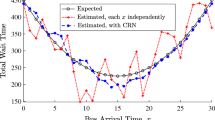Abstract
Pure adaptive seach iteratively constructs a sequence of interior points uniformly distributed within the corresponding sequence of nested improving regions of the feasible space. That is, at any iteration, the next point in the sequence is uniformly distributed over the region of feasible space containing all points that are strictly superior in value to the previous points in the sequence. The complexity of this algorithm is measured by the expected number of iterations required to achieve a given accuracy of solution. We show that for global mathematical programs satisfying the Lipschitz condition, its complexity increases at mostlinearly in the dimension of the problem.
Similar content being viewed by others
References
Personal communication from an anonymous referee (February 1990).
F. Archetti, B. Betro and S. Steffe, “A theoretical framework for global optimization via random sampling,” Working Paper, Quaderno dei Gruppi di Recerca Matematica del CNR, University of Pisa (Pisa, 1975).
H.C.P. Berbee, C.G.E. Boender, A.H.G. Rinnooy Kan, C.L. Scheffer, R.L. Smith and J. Telgen, “Hit-and-run algorithms for the identification of nonredundant linear inequalities,”Mathematical Programming 37 (1987) 184–207.
A. Boneh, “A probabilistic algorithm for identifying redundancy by a random feasible point generator (RFPG),” in: M.H. Karwan, Bl Lotfi, J. Telgen and S. Zionts, eds.,Redundancy in Mathematical Programming (Springer, Berlin, 1983).
S.H. Brooks, “A discussion of random methods for seeking maxima,”Operations Research 6 (1958) 244–251.
D.J. Clough, “An asymptotic extreme-value sampling theory for estimation of a global maximum,”CORS Journal 7 (1969) 102–115.
L.C.W. Dixon and G.P. Szegö, eds.,Towards Global Optimization (North-Holland, Amsterdam, 1975).
L.C.W. Dixon and G.P. Szegö, eds.,Towards Global Optimization 2 (North-Holland, Amsterdam, 1978).
R.M. Freund, “Polynomial-time algorithms for linear programming based only on primal scaling and projected gradients of a potential function,” MIT Working Paper OR-182-88 (Massachusetts Institute of Technology, Cambridge, MA, 1988).
J. Galambos,The Asymptotic Theory of Extreme Order Statistics (Wiley, New York, 1978).
C.C. Gonzaga, “Polynomial affine algorithms for linear programming,” Report ES-139/88, Federal University of Rio de Janeiro (Rio de Janeiro, 1988).
L. De Haan, “Estimation of the minimum of a function using order statistics,”Journal of the American Statistical Association 76 (1981) 467–469.
P. Huard, “Resolution of mathematical programming with non-linear constraints by the method of centers,” in: J. Abadie, ed.,Non-Linear Programming (North-Holland, Amsterdam, 1967) pp. 207–219.
N. Karmarkar, “A new polynomial-time algorithm for linear programming,”Combinatorica 4 (1984) 373–395.
M.G. Kendall,A Course in the Geometry of n-Dimensions (Hafner, New York, 1961).
N.R. Patel and R.L. Smith, “The asymptotic extreme value distribution of the sample minimum of a concave function under linear constraints”,Operations Research 31 (1983) 789–794.
N.R. Patel, R.L. Smith and Z.B. Zabinsky, “Pure adaptive search in Monte Carlo optimization,”Mathematical Programming 43 (1988) 317–328.
J. Renegar, “A polynomial-time algorithm, based on Newton's method, for linear programming,”Mathematical Programming 40 (1988) 59–93.
A.H.G. Rinnooy Kan and G.T. Timmer, “Stochastic methods for global optimization,”American Journal of Mathematical and Management Sciences 4 (1984) 7–40.
A.H.G. Rinnooy Kan and G.T. Timmer, “Stochastic global optimization methods part I: clustering methods,”Mathematical Programming 39 (1987) 27–56.
A.H.G. Rinnooy Kan and G.T. Timmer, “Stochastic global optimization methods part II: multi-level methods,”Mathematical Programming 39 (1987) 57–78.
R.Y. Rubinstein, “Generating random vectors uniformly distributed inside and on the surface of different regions”,European Journal of Operations Research 10 (1982) 205–209.
S.M. Ross,Stochastic Processes (Wiley, New York, 1983).
G. Schrack and N. Borowski, “An experimental comparison of three random searches,” in: F. Lootsma, ed.,Numerical Methods for Nonlinear Optimization (Academic Press, London, 1972) pp. 137–147.
M.A. Schumer and K. Steiglitz, “Adaptive step size random search,”IEEE Transactions on Automatic Control AC-13 (1968) 270–276.
R.L. Smith, “Efficient Monte Carlo procedures for generating points uniformly distributed over bounded regions,”Operations Research 32 (1984) 1296–1308.
F.J. Solis and R.J.-B. Wets, “Minimization by random search techniques,”Mathematics of Operations Research 6 (1981) 19–30.
Author information
Authors and Affiliations
Additional information
This work was supported in part by NATO grant 0119/89.
Rights and permissions
About this article
Cite this article
Zabinsky, Z.B., Smith, R.L. Pure adaptive search in global optimization. Mathematical Programming 53, 323–338 (1992). https://doi.org/10.1007/BF01585710
Received:
Revised:
Issue Date:
DOI: https://doi.org/10.1007/BF01585710




